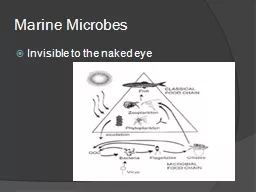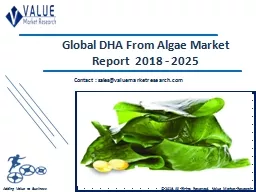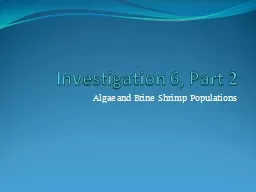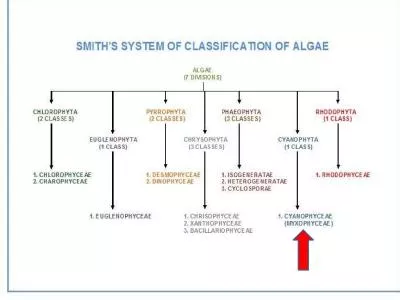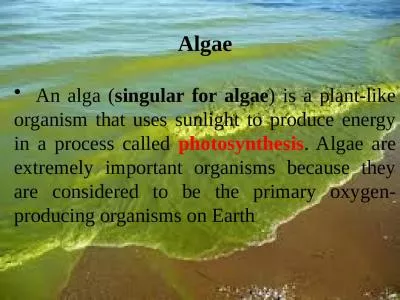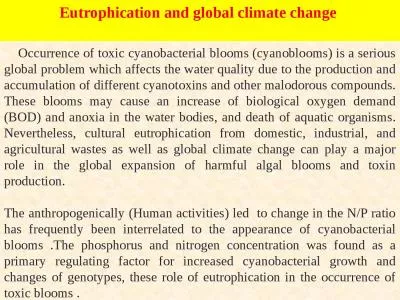PDF-CHAPTER 8Algae and cyanobacteria in fresh waterhe term algae refers to
Author : tawny-fly | Published Date : 2016-04-17
81Occurrence of toxic cyanobacteriaxic cyanobacteria are found worldwide in inland and coastal water environmentsleast 46 species have been shown to cause toxic
Presentation Embed Code
Download Presentation
Download Presentation The PPT/PDF document "CHAPTER 8Algae and cyanobacteria in fres..." is the property of its rightful owner. Permission is granted to download and print the materials on this website for personal, non-commercial use only, and to display it on your personal computer provided you do not modify the materials and that you retain all copyright notices contained in the materials. By downloading content from our website, you accept the terms of this agreement.
CHAPTER 8Algae and cyanobacteria in fresh waterhe term algae refers to: Transcript
81Occurrence of toxic cyanobacteriaxic cyanobacteria are found worldwide in inland and coastal water environmentsleast 46 species have been shown to cause toxic effects in vertebrates Sivonen ones. synthesis of amorphous Mg-, Ca-, Sr- and Ba-carbonates: . what do we learn about intracellular calcification by cyanobacteria?. Nithavong Cam. 1, 2. . Jean-François Lambert. 1. , . Karim. Benzerara. Invisible to the naked eye. . Extremophiles . phile. - lover of. What is an Extremophile?. An extremophile is an organism that thrives under "extreme" conditions. . They are prokaryotes in the kingdom . Keith Herbert. Synthetic Biology with Cyanobacteria. Cox PA, . Banack. SA, . Murch. SJ, et al. Diverse taxa of cyanobacteria produce beta-N-. methylamino. -L-alanine, a neurotoxic amino acid. . Proc. All are free-floating. All capture light energy by oxygenic photosynthesis . All use a suite of photosynthetic pigments that includes Chlorophyll a.. Major Groups of Freshwater . Phytoplankters. Blue-Green Algae- . Membership Meeting. March 15, 2018. . Cyanobacteria &. Cyanotoxins:. What PWSs . should know. Photo Credit: G. Zoto, MassDEP. Naturally occurring microorganisms (bacteria) formerly known as blue-green . DHA From Algae Market Report published by value market research, it provides a comprehensive market analysis which includes market size, share, value, growth, trends during forecast period 2019-2025 along with strategic development of the key player with their market share. Further, the market has been bifurcated into sub-segments with regional and country market with in-depth analysis. View More @ https://www.valuemarketresearch.com/report/dha-from-algae-market Bacteria. Archaea. Lobose amoebae. Cellular slime molds. Plasmodial slime molds. Fungi. Choanoflagellates. Animals. Parabasilids. Diplomonads. Euglenids. Kinetoplastids. Glaucophyte algae. Red algae. ‘MaCuMBA stands for witch craft and black magic, as still much of the cultivation of marine microorganism is to us’. . 22 partners . from. 11 European . countries. Microbes. : The . U. nseen. . SpiresMatsBlobsRooted PlantsFloating PlantsPlantlike AlgaeFilamentous AlgaeScum Bubbling or Spitlike Floating FoamPaint or SoupLettuce or Chopped GrassThis quick guide provides a visual comparison of Shrimp Populations. Warm up. What is a limiting factor?. Give some examples.. Any biotic or abiotic factor that acts in some way to limit the number of individuals that survive and reproduce in a population. . or . Cyanophyta. (Blue green algae). Division :. Cyanobacteria. or . Cyanophyta. (Blue green algae). Called blue-green bacteria( . Cyanobacteria. ) because there are similarities between division and bacteria, including:. ) is a plant-like organism that uses sunlight to produce energy in a process called . photosynthesis. . Algae are extremely important organisms because they are considered to be the primary oxygen-producing organisms on Earth. cyanobacterial. blooms (. cyanoblooms. ) is a serious global problem which affects the water quality due to the production and accumulation of different . cyanotoxins. and other malodorous compounds. These blooms may cause an increase of biological oxygen demand (BOD) and anoxia in the water bodies, and death of . Algai. Toxins. Dr. Ayat B. Al-. Ghafari. Associate Professor of Biomedical Sciences. e.mail. : abalghafari@kau.edu.sa. Algae refers to a large and diverse group of aquatic organisms that contain chlorophyll and carry out oxygenic photosynthesis. .
Download Document
Here is the link to download the presentation.
"CHAPTER 8Algae and cyanobacteria in fresh waterhe term algae refers to"The content belongs to its owner. You may download and print it for personal use, without modification, and keep all copyright notices. By downloading, you agree to these terms.
Related Documents


